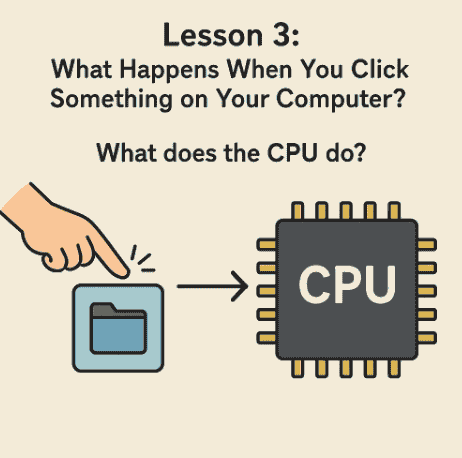
🟣 A Quick Reminder:
In Lesson 1, we learned the CPU is like the brain — it thinks and gives orders.
In Lesson 2, we saw how the RAM is like a whiteboard (it helps the CPU work quickly), and the Storage is like a bookshelf (it keeps stuff safe for later).
Now… let’s put all of that together!
🖱️ You Click a Button — What Happens Next?
Imagine you’re on your computer. You see a fun app or game. You click it.
Here’s what goes on inside:
-
Your finger clicks the mouse.
-
The mouse sends a tiny electric message to the computer.
-
The CPU gets the message and says, “Okay! Let’s open the app.”
-
It goes to storage and finds the app.
-
It moves the app to RAM so it can work on it faster.
-
The CPU starts reading the app’s instructions — one by one.
-
You see the app open on your screen.
All of this happens in less than a second. Super fast!
⚙️ Why Doesn’t the App Run from Storage?
Because storage is slow.
The CPU says:
“I don’t want to keep running back to the bookshelf every time I need a word! I’ll copy what I need onto my desk (RAM) so I can grab it faster!”
So:
-
Storage = where the app lives
-
RAM = where the app plays
-
CPU = who reads and follows the app’s instructions
🧠 What Kind of Instructions?
All apps are made of instructions.
These tell the CPU things like:
-
“Show this picture on the screen.”
-
“Play this sound.”
-
“Wait for the user to click a button.”
-
“Add these numbers.”
-
“Move this character forward.”
The CPU reads these instructions from RAM and does them — again and again and again.
It never gets tired!
🎨 What If You Click on a Picture?
Let’s say you click on a photo to look at it.
Here’s what happens:
-
You click the photo.
-
The CPU gets the message.
-
It goes to storage and finds the photo.
-
The photo is made of 0s and 1s (tiny bits).
-
The CPU sends those 0s and 1s to the screen.
-
The screen turns them into colors — and you see the picture!
Your eyes see the picture, but inside, it’s just electric signals and numbers.
🎮 What If You Click to Play a Game?
This one’s a bit longer. But let’s break it down.
-
You click the game icon.
-
The CPU wakes up and says, “Let’s do this!”
-
It finds the game in storage.
-
It loads the game into RAM.
-
It starts reading the game’s instructions.
-
The game tells the CPU:
-
Draw a character
-
Show a level
-
Wait for keyboard or mouse input
-
Make things move or make sounds
-
And it does this millions of times every second.
It feels like magic — but it’s just fast thinking and hard work by the CPU.
🤔 But Wait — How Does the CPU Know What to Do?
Every button click, every app, every game…
They’re all made of instructions.
These instructions are written in a language the CPU can understand — a very, very simple language made of 0s and 1s.
We call this machine code.
And guess what?
Every instruction is like:
➡️ Do this thing
➡️ With this number
➡️ And save the answer here
That’s all the CPU needs to get started!
📶 Why Is RAM Important Here?
RAM is where the app or game lives while you’re using it.
If the app stayed in storage the whole time, it would run slowly.
With RAM, the CPU can grab instructions right away.
It’s like:
-
Storage = your bookshelf
-
RAM = your desk
-
CPU = you
Try doing homework while running back and forth to the bookshelf every second — not fun!
Much better to keep stuff on your desk, right?
💡 What If You Click Two Things at Once?
Let’s say you open a browser and a video player at the same time.
The CPU doesn’t get confused.
It takes turns.
Like this:
-
CPU: “Browser, I’ll help you for a moment.”
-
CPU: “Okay, video player, your turn now.”
-
CPU: “Back to browser. Need anything?”
-
CPU: “Video again!”
It switches really fast — so fast you think both are running at the same time.
🧼 What Happens If You Turn Off the Computer Mid-Click?
If you click something and then shut down your computer:
-
RAM forgets everything
-
CPU stops working
-
Storage keeps the files safe
So when you turn the computer back on, the CPU will need to go back to storage and start again.
That’s why it’s a good idea to save your work before shutting down.
Simple Chart: What Happens When You Click
| Step | What Happens |
|---|---|
| 1. | You click a button |
| 2. | CPU gets the message |
| 3. | CPU goes to storage |
| 4. | CPU moves app to RAM |
| 5. | CPU reads instructions |
| 6. | CPU does the work and shows you the result |
That’s it!
In the next part, we’ll open the curtain and look inside the CPU.
We’ll learn what tiny pieces live in there and how they work together — step by step!